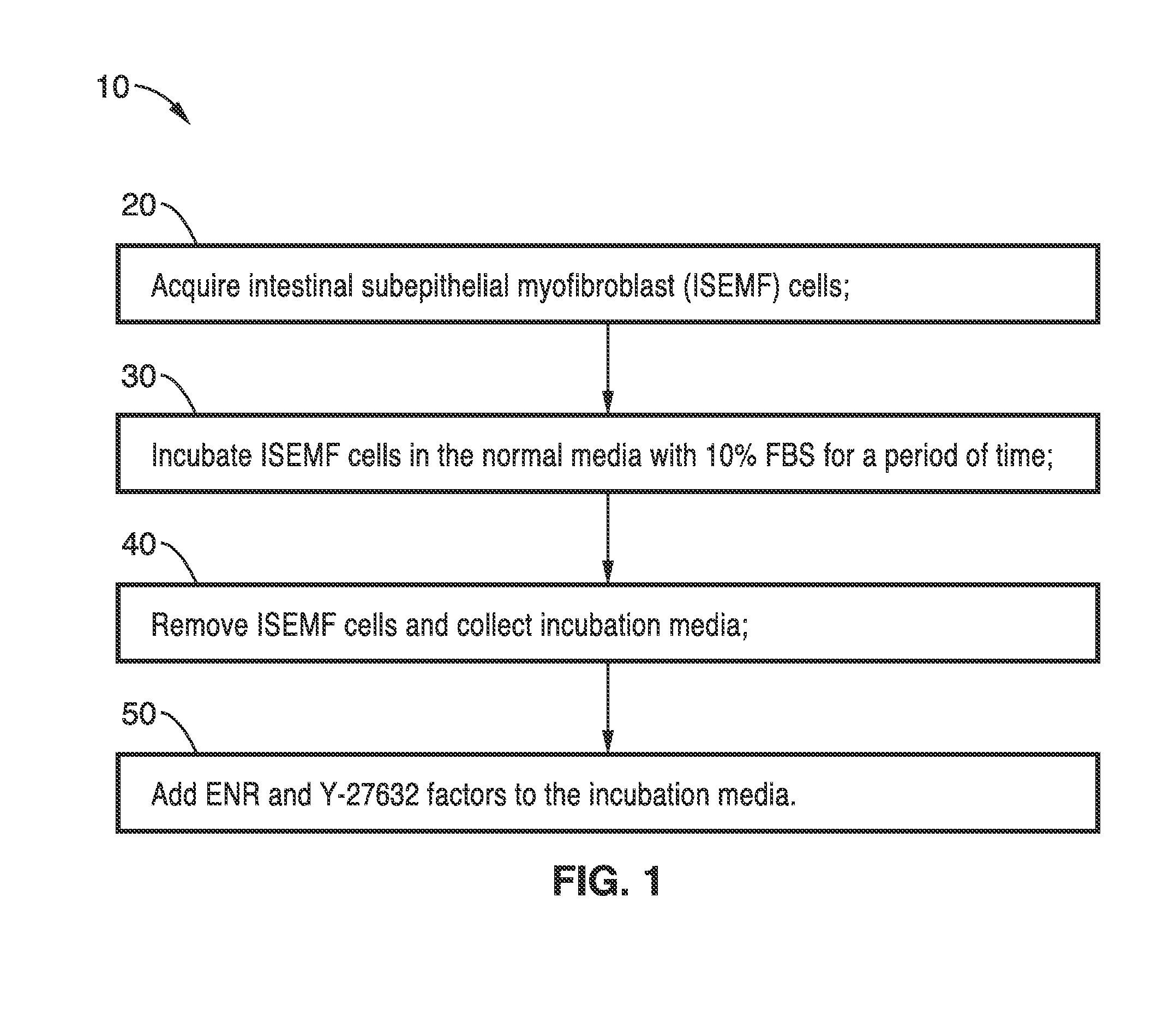Method to expand and transduce cultured human small and large intestinal stem cells
a technology of stem cells and cultures, applied in the direction of artificial cell constructs, biocide, genetic material ingredients, etc., can solve the problems of intransferable methods and prone to injury of iscs
- Summary
- Abstract
- Description
- Claims
- Application Information
AI Technical Summary
Benefits of technology
Problems solved by technology
Method used
Image
Examples
example 1
[0046]In order to demonstrate the operational principles of the culture media and methods, ISEMF cells were isolated from five-day old wild type C57BL / 6 neonates, in which mesenchyme-rich small intestinal organoids were harvested using gentle enzymatic digestion and plated at a density of 5,000 per mL of ISEMF media. This media consisted of Dulbecco's modified Eagle medium (DMEM) / Low Glucose / GlutaMAX (Invitrogen, Carlsbad, Calif.) with 10% FBS (Invitrogen), lx Antibiotic-Antimycotic (Invitrogen), 0.25 U / mL insulin (Sigma, St. Louis, Mo.), 10 mg / mL transferrin (Sigma), and 20 ng / mL recombinant murine epidermal growth factor (EGF, Peprotech, Rocky Hill, N.J.). After ISEMF cells attached and formed colonies, they were subsequently passaged and expanded using standard cell culture techniques. In preparation for co-culture, ISEMF cells were seeded into 48-well cell culture plates, with and without pre-treatment with gelatin, and allowed to grow to confluency. For conditioned media (CM) e...
example 2
[0048]To further demonstrate the supportive effects of ISEMFcells in intestinal epithelial culture, small and large intestinal crypts were cultured in the presence and absence of ISEMF cells. When treated with media lacking exogenous Rspo1, crypt monocultures did not form enteroids and died within two days of plating, highlighting the necessity for Rspo1. However, it was observed that crypts co-cultured with ISEMF cells successfully formed enteroids even in the absence of exogenous Rspo1.
[0049]Crypts were grown with and without ISEMF-conditioned culture medium ISEMF-CM to assess the necessity of interaction between ISEMF cells and the epithelial cells. ISEMF CM was collected from confluent ISEMF cells in monoculture after 5 to 7 days of incubation as described earlier and filtered to eliminate cell contamination. Crypts grown with media containing ISEMF-CM were 3 times larger (0.08760.029 mm2 versus 0.03860.016 mm2; p=0.03) than those without conditioned media. These data suggest th...
PUM
| Property | Measurement | Unit |
|---|---|---|
| pore size | aaaaa | aaaaa |
| genetic defect | aaaaa | aaaaa |
| area | aaaaa | aaaaa |
Abstract
Description
Claims
Application Information
 Login to View More
Login to View More - R&D
- Intellectual Property
- Life Sciences
- Materials
- Tech Scout
- Unparalleled Data Quality
- Higher Quality Content
- 60% Fewer Hallucinations
Browse by: Latest US Patents, China's latest patents, Technical Efficacy Thesaurus, Application Domain, Technology Topic, Popular Technical Reports.
© 2025 PatSnap. All rights reserved.Legal|Privacy policy|Modern Slavery Act Transparency Statement|Sitemap|About US| Contact US: help@patsnap.com

